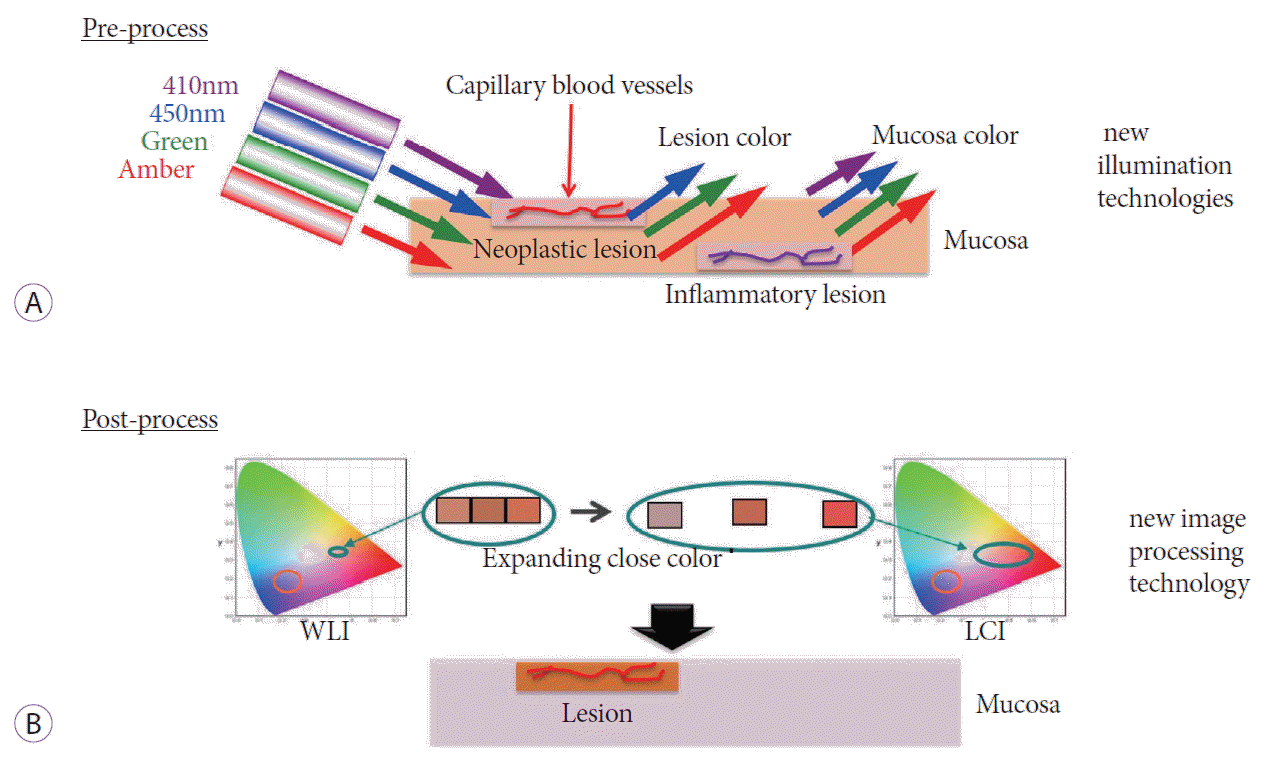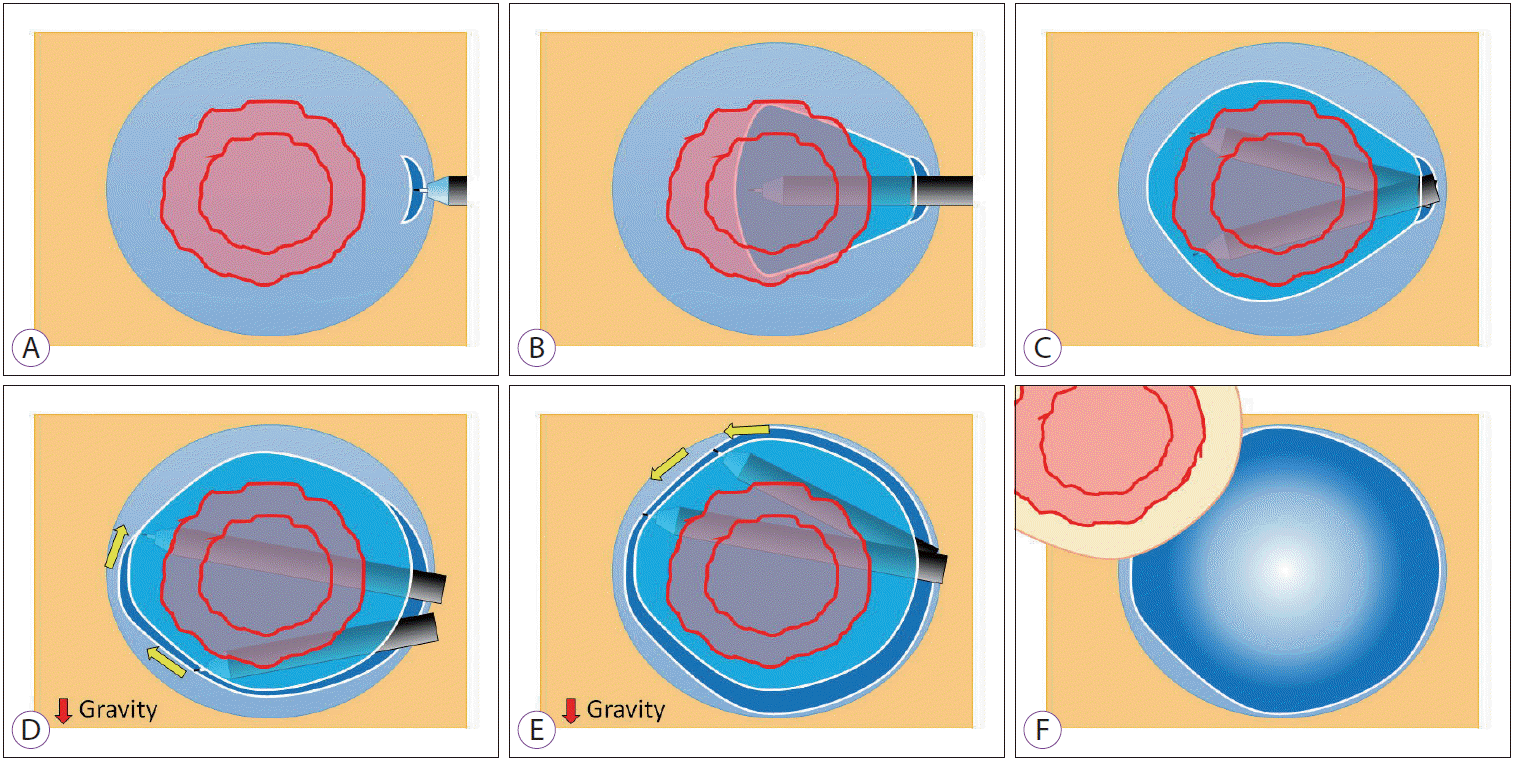INTRODUCTION
ENDOSCOPIC RESECTION OF SUPERFICIAL COLORECTAL NEOPLASM
THE POCKET-CREATION METHOD
 | Fig. 2.Advantages of the pocket-creation method (PCM). Minimal mucosal incision prevents dispersion of injected solution resulting in long-lasting maintenance of mucosal elevation. In the pocket, both traction and countertraction are obtained, and the tip of the endoscope is stabilized. Even in difficult locations, PCM enables stable submucosal dissection. A stabilized endoscope in the pocket synchronizes cardiac and respiratory movement. |
COLD SNARE POLYPECTOMY
EARLY DETECTION AND RESECTION
CHARACTERISTICS OF LINKED-COLOR IMAGING
 | Fig. 3.(A) Pre-processing illumination technology of linked-color imaging (LCI): 410-nm violet light can penetrate only a short distance from the mucosal surface and is easily absorbed by hemoglobin. Typically, the dilated microvasculature is concentrated in the superficial mucosa in neoplastic lesions and in the deep mucosa in inflammatory lesions. Therefore, the 410-nm violet light is absorbed by neoplastic lesions but is reflected by inflammatory lesions. (B) The post-processing technology of LCI: color contrast is enhanced to make the red and white lesions become redder and whiter, respectively. WLI, white light imaging. |
EARLY DETECTION OF COLORECTAL SUPERFICIAL LESION WITH LCI
 | Fig. 4.small sessile sigmoid colon polyp. (A) Easily detected by linked-color imaging. (B) Difficult detection by white-light imaging. (C) Blue laser imaging scan with magnification shows meshed capillaries compatible with a benign neoplastic lesion (JNET type 2A). (D) Cold-snare polypectomy. |
 | Fig. 5.A small sessile sigmoid colon polyp. (A) Easy detection by linked-color imaging. (B) Difficult detection by white-light imaging. (C) Blue laser imaging scan with magnification shows meshed capillaries (JNET type 2A). (D) Cold-snare polypectomy. |
 | Fig. 6.A small sessile rectal polyp. (A) Easy detection by linked-color imaging. (B) Difficult detection by white-light imaging. (C) Blue laser imaging scan with magnification shows meshed capillaries (JNET type 2A). (D) Cold-snare polypectomy. |
 | Fig. 7.Early colon cancer in the transverse colon. (A) Detectable using linked-color imaging. (B) Difficult detection by white light imaging. (C, D) Blue laser imaging scan with magnification shows irregular capillaries and an irregular surface pattern (JNET type 2B) that suggests superficial carcinoma. |
 | Fig. 8.Endoscopic submucosal dissection of a laterally spreading tumor of non-granular pseudo-depressed type (the lesion in Fig. 7), using the pocket-creation method. (A) Mucosal elevation using sodium hyaluronate. (B) Submucosal dissection in the pocket. (C) Blue laser imaging scan of the resected specimen shows irregular capillaries (JNET type 2B). (D) Chromoendoscopy image with indigocarmine dye spray of the resected specimen shows en bloc resection. Pathology: Well-differentiated tubular adenocarcinoma, 25×21 mm in size, and intramucosal cancer with no lymphatic and venous invasions, and negative resection margins. A complete en bloc resection. |




 PDF
PDF Citation
Citation Print
Print




 XML Download
XML Download